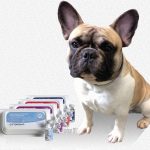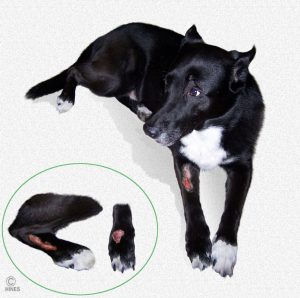Ron Hines DVM PhD
 Could separation anxiety be a part of my problem?
Could separation anxiety be a part of my problem?
 Do fears & phobias contribute to my problem?
Do fears & phobias contribute to my problem?
 Only a few improved with Cytopoint®
Only a few improved with Cytopoint®
Dogs (and occasionally cats) lick themselves raw for a number of reasons. Sometimes it is very hard for your veterinarian and you to determine what those reasons are. I find that most often it is a combination of factors – some physical and some psychological – that interact and lead to this problem. In every case, your dog’s unique temperament is an important factor. So, no one treatment will cure all dogs of an acral lick problem. Often your veterinarian will use trial and error, or a number of treatments simultaneously to attempt to cure your dog. Some pets cannot be completely cured of this problem. But all can be made better. You will need patience and persistence.
What is Acral lick dermatitis?
“Acral” means the body’s extremities such as hands, arms and legs. But veterinarians use the word to describe sores that occur on the legs, ears, nose and tails of pets. They do not heal because dogs persistently lick them. That forms a lick granuloma, a sore or sores that cannot heal. They often appear on your pet’s lower leg. Since it is your pet’s behavior that generates them, they never occur where a pet cannot reach them to lick or chew. Although due to an entirely different cause, lick granuloma sores looks somewhat similar to the bed sores that occur in debilitated people due to poor circulation and pressure.
Acral lesions most commonly affects the lower legs in an area that a resting dog can comfortably reach while laying on its stomach or side. The problem can occur in high-strung, obsessive, anxious or stressed pets of any age. But veterinarians see it most often in older (6+ years or so) larger dogs that have begun to slow down and move about less. That could be due to underlying joint issues, arthritis or obesity. It can also be due to changes in your own life patterns that deny the pet your company.
Acral granulomas occurs most commonly in Doberman pinchers, Labrador retrievers, golden retrievers, their crosses and other large active breeds. In those dogs, your pet’s individual genetics are a large contributors to the problem. (read here) That is why, in most cases, your veterinarian cannot identify any underlying health problems that account for its behavior. However, some cases do have a specific underlying non-genetic, non-social and curable cause. (read here)
Lick-related, chewing and scratching or hair loss problems account for a large percentage of your veterinarian’s hospital visits. In Montreal, skin problems accounted for a fifth of all veterinary teaching hospital visits. In Mid-America, where fleas and allergies are worse, that percentage is considerably greater. You can read more about those Montreal veterinary visits here.
Acral lesions usually occur where bone and skin are in close proximity (close together). That is why when the affected area(s) on your dog is over heavy muscle, fat, or the torso, a biopsy to rule out an underlying tumor or infection is always a good idea. The same goes for lesions in all areas that would be difficult for your pet to easily lick and groom.
More About The Problem
Some of the dogs that suffer from this problem are found to be hypothyroid. In others, age, arthritis and/or obesity have made them less mobile. So, they spend more and more time grooming themselves and worrying small areas of their skin – activities that require less energy and can be performed in a resting position. If your dog is older, and you suspect that its limited mobility is adding to the licking problem (or is the cause of it), you can read about arthritis treatment in dogs here and some of the special needs of older dogs here. Sometimes dog owners suspect that a bee sting or spider bite was the underlying cause. But I have found that that is rarely the case.
It is very uncommon for a dog to have more than one or two of these spots on his or her body. As they continuously lick these areas, hair is lost, the area becomes firm and raised and superficial staphylococcal infections often appear (furunculosis). With time, the skin of that area on your pet tends to either gain color or looses pigment. These resulting, self-inflicted wounds, are sometimes called granulomas. The center of these lesions is usually ulcerated by the time clients bring me their pets. These wounds are unsightly but never life-threatening. They are rarely painful when touched, and I suspect that they look worse than they feel. Scabs rarely form because of the incessant licking.
What Do You Think Is The Most Common Cause This Problem?
I believe that boredom, confinement, loneliness, separation anxiety and a decreased ability to move about are the root causes of most cases of acral lick dermatitis that veterinarians see. You can read about other self-destructive behaviors that separation anxiety can cause here. It can be very difficult to determine whether physical or psychological problem are more important in causing your pet’s obsessive licking and grooming of the area(s). Even diet can affect your dog’s mood and activities. You might experiment with some of the dietary modifications you find here and here. Environmental enrichment, with things like Kong™ toys might be quite helpful too.
might be quite helpful too.
If you have noticed allergic problems in your pet over the years, explore the possibility that acral lesions have become a new part of that problem. But do not confuse the interdigital (between the toes) pus pockets and infections (interdigital cysts, interdigital pyoderma) with acral lesions. Those lesions are due to the dampness of constant paw-licking and its breakdown of the outer protective layer of the skin. For that problem, you need to read this article as well.
What Are My Veterinarian’s Other Treatment Options?
Besides my earlier suggestions, the most effective way to eliminate this problem is to use a muzzle on your dog when you are not available to interact with and supervise it. Bandaging the area with a light dressing during those periods is another option. Bitters sprays and ointments rarely work. You are likely to be most successful when you begin treating these lesions early. After years of licking, it becomes an ingrained habit and few if any treatments are successful at eliminating their urge to lick.
Many mood-altering drugs have been dispensed. I only suggest their temporary use in conjunction with the non-drug, behavioral modification I mentioned earlier. They also have a valid use prior to your pet being faced with a temporary, stressful situation that in the past cause anxiety. Veterinarians have dispensed clomipramine (Clomicalm®), acepromazine, buspirone (Buspar®) amitriptyline (Elavil®), fluoxetine (Reconcile®/Prozac®), medetomidine (Sileo®), alprazolam (Xanax®) and various other antidepressants. With all of them, successes are mixed. Trazodone is also sometimes issued, but it too is not without risk. (read here).
A medication that is sometimes used to treat addictions in humans, naltrexone, has been reported as being occasionally helpful to dogs suffering from lick granuloma. Other veterinarians reported that they occasionally found phenobarbital helpful. Like dogs that receive phenobarbital to treat their epilepsy, blood chemistry values (especially liver enzymes) need to be carefully monitored while taking it. Most veterinarians do not dispense those two drugs for lick granulomas.
Frequent, small feedings and puzzle feeders and other forms of cognitive enrichment are very helpful in relieving boredom.
If your veterinarian believes that an arthritis-related lack of motility and resulting boredom might be an underlying co-factor, your vet might put your dog on a test period of an anti-arthritic NSAID drug such as carprofen (Rimadyl®). If a significant secondary bacterial skin infection exists, a broad spectrum skin antibiotic could help get the infection under control. Steroid-containing topical antibiotic ointments (such as Panalog®) retard (delay) skin healing. They should be avoided.
No mater what the underlying cause and treatment might be, it is common to place these pets in a restrictive collar, muzzle or bandage to give the lesion a chance to heal. I prefer a well-fitting muzzle – if your dog will agree to it. After a few days, most dogs will not object to a muzzle if it fits comfortably. You can see a well-fitted muzzle here . Pets only need to wear these devices when you are unable to supervise them. Most dogs quickly learn that you do not want them worrying the area and a concerned glance or word is usually all it takes to make them stop.
. Pets only need to wear these devices when you are unable to supervise them. Most dogs quickly learn that you do not want them worrying the area and a concerned glance or word is usually all it takes to make them stop.
There is one theory that licking these lesions releases “feel good” endorphins (brain chemicals), which cause the cycle to continue. I do not know of any medication that would break such a cycle without causing other, more objectionable, side effects.
What About Just Having My Veterinarian Surgically Remove The Affected Area?
I would strongly discourage you from doing that. I have never seen a case where surgically removing the diseased tissue cured a dog. It will almost certainly begin to lick and chew at that, or another area again. Surgery puts tension on the remaining skin and can result in the need for much more extensive reconstructive surgery later. You can read about that here. (“previously excised” means previously cut off). In desperation, these inflamed areas have also been treated with radiation. Some veterinarians claim success in doing so. It is not a procedure that I would suggest.
What About Antibiotics?
Antibiotics might be helpful if the lesion has developed pussy areas or tracts or if moist bandages have encouraged bacterial growth. But they will not cure true acral lesions. They will eventually lead to antibiotic-resistant bacteria in your home – a threat to both you and your dog. When bandages are used, an antiseptic powder (such as boric acid or povone iodine powder) is a better option.
New Age Treatments
Some veterinarian, somewhere, sometime, has tried just about everything – from acupuncture or laser treatments to cobra venom to treat acral lick granuloma. (read here) An occasional dog will appear to improve after these treatments. But there is really no scientific evidence that the improvement had anything to do with what was done. Most are harmless, give them a try if you wish.
What Is The Outlook For My Pet?
The good news is that this condition is generally no more than an unsightly blemish. The bad news is that veterinarians may not be able to cure it once it becomes a well-established habit. Again, the earlier it is recognized and treated the more hope there is for a permanent cure. If the problem is truly an acral granuloma and if you can keep your pet from licking the area – it will almost certainly heal. I personally greatly prefer using mechanical and behavior modification means of doing that rather than powerful oral or injectable medications.
Can One Dog Catch This Problem From Another? Can It Spread To Me?
No.
But it is always wise to wash your hands after touching these areas on your dog. There is also always the possibility of producing resistant bacteria that can spread to other human, canine or feline family members when this problem is treated repeatedly with antibiotics. Whatever bacteria your dog harbors will eventually find their way to you as well. (read here, here & here) That is not the case when gentle antiseptics are used topically. Antiseptics are not antibiotics. As far as veterinarians and physicians know, no bacteria have as yet become resistant to antiseptics. (read here)
You are on the Vetspace animal health website
Visiting the products that you see displayed on this website help pay the cost of keeping these articles on the Internet.


